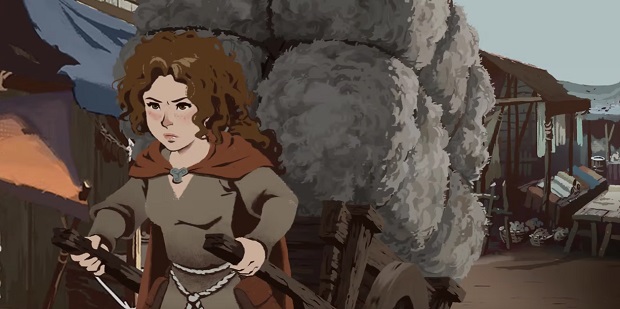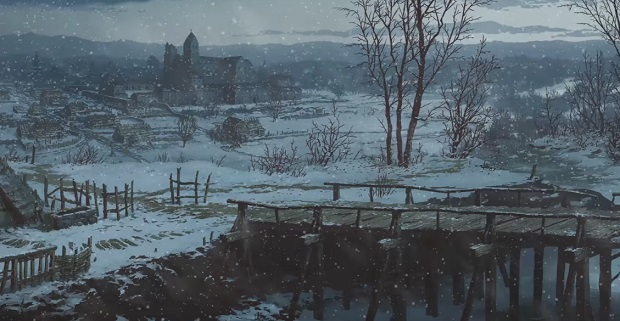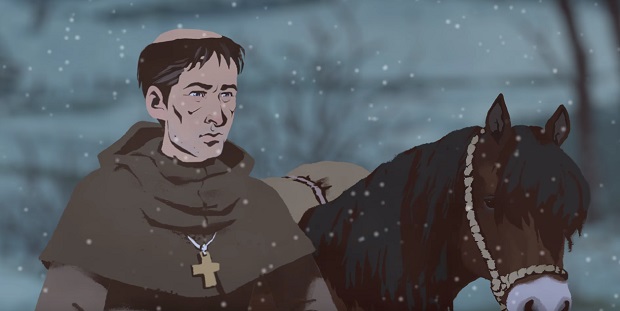Pillars of the Earth takes on Telltale at their own game
Cathedral Tycoon
The Pillars of the Earth [official site] is doing a lot of difficult things and based on a brief play session earlier this week, I reckon it might be doing most of them very well indeed. I wasn’t quite sure what to expect, having never been a fan of Daedalic’s previous point-and-click output, but I came away impressed by both the tone and the design of this upcoming adaptation of Ken Follett's novel about that raciest of topics: cathedral construction in 12th century England.
Let’s look at the difficulties. This is a point-and-click adaptation of an enormous novel, so there’s an editorial job up-front, deciding precisely which subplots and scenes to include across the three ‘books’ that will make up the entire game. Then there’s the content of those scenes, many of which touch on matters of faith, the brutality of life in 12th century England, a complex political situation, and sacred architecture.
It’s weighty stuff and could ask a lot of players who don’t have a grounding in the period, or indeed in the novel itself. All that said, the trickiest task of all might come from the introduction of choices that can change the story. Adaptation always requires rewriting, because each medium has its own strengths and limitations, but adding branching narrative elements to a plot that already fills a gargantuan novel, and covers several decades, creates obvious complications.
In the half hour chapter of the game I played a couple of days ago, at Daedalic’s offices, there were signs that the team behind the game (the largest the studio has ever produced) are handling all of those difficulties well. Though the game controls like a traditional point and click adventure (though there’s a joypad scheme as well as the mouse cursor), it’s quietly innovative. The decision-making resembles Telltale’s take enough that it doesn’t strike me as particularly novel, though narrative designer Valentina Tamer told me about a few examples of long-term consequences that sound impressive.
It’s impossible to say how well those aspects of the game will work until it’s in our hands though. What does work is a simple change to the way something as simple as looking at things works.
John has said before that adventure games without a look button are missing many opportunities for character-building, jokes and storytelling. I think he’s absolutely right and one of the small tweaks to the usual formula that the Pillars team have implemented involves a change to that verb, ‘look’. Right clicking items, people or locations causes your character to ‘think’ about whatever is under the cursor rather than to ‘look’ at it.
That serves two purposes. Primarily, though the game is entirely voiced when characters speak, the thoughts are presented as text on the screen. That means thoughts don’t interrupt the flow of the game, and you can cycle through thoughts quickly by clicking around the screen. For most hotspots, thoughts are delivered in fragments, so a series of clicks will reveal several phrases. It’s a small adjustment to the usual manner of looking at things, but it works well, both as an expression of inner monologues, doubt and fears, and as a way to communicate the details of the world in text.
That text is a supplement to some beautiful background art. It’s detailed and well-researched, the cloisters and half-finished cathedral particularly dramatic. During a studio tour, I saw artists’ desks stocked with books on medieval architecture but it’s not just the design of the building that has been put on screen, it’s the light and shadow that give life to Kingsbridge. It’s a place filled with people and with a authentic layers of grime on top of all the artifice.
The people were the least convincing part at first glance. They’re animated well and somewhat reminiscent of the characters in The Banner Saga, but I wasn’t convinced that they fitted with the backgrounds, thinking they were perhaps a little too stylised to gel with the world. That feeling faded quickly though. The animations and expressions add to their personalities, and the overall art style is an exaggerated realism rather than a pure recreation.
I’m curious to see how the puzzles will develop. Based on what I’ve seen and what Tamer told me, 'puzzles' isn’t really the right word. There is an inventory, which contains both items and abstract clues and pieces of knowledge, and these can be used on objects in the world, or people. Rather than combining a piece of string with a rubber chicken, you’ll be bargaining and plotting, figuring out how to move the story forward, and in what direction.
The chapter I played took place in the woods outside Kingsbridge and I was playing as a young boy, raised by his outlaw mother in a cave, beyond the reach of the monks and other men who might control them. I killed a deer, which involved a very simple QTE, failed to save the meat of that deer from spoiling, found an abandoned baby, and encountered a few characters who I failed to befriend.
If the rest of the game plays out in a similar fashion, it’ll be more Telltale than traditional point-and-click. That comparison snuck up on me because I was expecting something that, mechanically if not tonally, would fit more with Daedalic’s past. It looks like a traditional adventure game but the story takes precedence, and there were no challenges to gate progression. Instead, the choice to take back a stolen book, and the manner in which to attempt the theft, led to different scenes and changed the nuance of relationships between characters.
It’s impossible to say whether the game will come together as a whole. I’ve seen a few scenes from a story that covers many years, and several playable characters, but I’m hopeful. And even though I don’t remember the novel all that well, having read it as a teenager, I’m happy to see an adventure game that strays away from sci-fi, fantasy and comic books. Historical fiction has its own rewards and medieval Europe is a wonderful setting for intrigue, as well as complex questions of faith and vocation.
There’s a scene within monastic grounds where two monks are salting fish in the foreground while Philip, a later playable character, follows a lead relating to a potentially sinister plot. It was that detail, these people working at one of the mundane jobs that keeps their cloistered society running, that I enjoyed more than any of the actual interactions.
The history around Europe’s great cathedrals is as fascinating as the mythology, both localised and spiritual, that these incredible works of architecture and labour stemmed from and provoked. Kingsbridge is a fictional place, but its concerns were real and if Daedalic can depict the setting and the people who inhabit it, this might be a step toward a much more mature and interesting phase in their decade-long history of adventure games.








